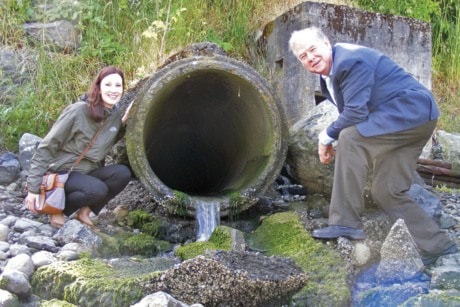We’re not doing enough to deal with storm water, says a local environmental research group.
The University of Victoria’s Environmental Law Centre has high expectations for how the region deals with runoff. While there have been some good piecemeal strategies, a watershed-wide plan is needed, said the centre’s legal director Calvin Sandborn.
“There’s been tremendous innovation that has happened at every level … it’s just a matter of pulling it together,” he said.
Storm water runs off roofs, down driveways and over pavement, collecting paint chips, oil, lead and other toxins before converging in storm drains and flowing out onto beaches and into waterways.
Natural absorption methods, or what the centre calls low-impact development, include rain gardens, green roofs and porous pavement. They absorb storm water through the soil, which filters the pollutants then returns clean water back to the watershed, instead of letting large quantities flow untreated into waterways. Toxins and high flow rates have wrecked the region’s shellfish beds and salmon streams, Sandborn said.
“If we could move to green rainwater management, we could have salmon streams all over Victoria.”
In some pipes, like the outdated ones in the Uplands subdivision, storm water and sewage flow together. The bacteria from the sewage are widely considered a public health hazard.
Right now municipalities only have bylaw jurisdiction over their tiny corner of the watershed, Sandborn said. While most already have their own strategies for dealing with storm water, many have different focuses and are at different stages of development.
“For this to work we have to take a system approach, we can’t divide up watersheds.”
ELC representatives have been making presentations to Capital Region municipalities since May 2010, urging them to adopt recommendations from a report published last year, which pushes low-impact development. Sandborn said they’ve generally had a positive response.
Based on one of the report’s recommendations, the City of Victoria plans to implement storm water utility. The flat rate will see homeowners charged for the storm water that flows off their property, based on the amount of pavement on the lot. Homeowners who choose to remove downspouts or put in rain gardens or green roofs would have their bill reduced.
The report also includes a suggestion that the Capital Regional District create a regional “rainwater commission” to allow municipalities to work together and to create a joint plan to deal with storm water.
But the CRD doesn’t see a unified plan as the only answer.
“I would say that a regional approach could be a very effective way of addressing the issue,” said Dale Green, who supervises storm water harbours and watersheds for the CRD. “I think the challenge right now is that all the municipalities are trying with the resources they have.”
The regional district has no way to regulate each local government, it just acts as a resource, said Green. He facilitates an inter-municipal task group a few times a year where ideas are exchanged, and resources and advice shared.
While civic boundaries aren’t designed around storm water catchment, the City of Langford has worked hard to manage its storm water drainage where it flows downstream to other municipalities, said head engineer John Manson.
He thinks municipalities do a good job of working together already. “I don’t think there’s much of a conflict.”
Langford came up with a plan for green storm water management several years ago. The results can be seen in the porous brick on Bryn Maur Road and the detention ponds and infiltrators at Bear Mountain and the Westhills housing development. Also, a lot of the new developments feature rock fill, which absorbs water and lets it flow into the soil.
Sandborn said while green technologies are more attractive, they’re also cheaper in the long run than redoing existing infrastructure, because solutions such as rain gardens cost little to install.
But first, everyone needs to co-operate.
“It’s doesn’t do us much good if local and regional governments get on board, but developers and homeowners don’t.”
intern@vicnews.com
Is it dangerous?
While storm water is considered a public health hazard, it’s a bigger issue in the fall and winter, says Vancouver Island Health Authority medical health officer Murray Fyfe.
High levels of bacteria and pathogens appear in the water when overflow from big storms spills into sewage pipes and the sewer system is overwhelmed, causing fecal material to flow onto beaches.
In many areas, liquid waste also flows into storm water pipes, as runoff and sewage are only separated by a low dividing wall.
In the Uplands subdivision in Oak Bay, storm water and sewage run together. Seepage also happens where there are in cracked pipes.
The Capital Regional District monitors storm water outflows and posts advisories if public health is at risk. Fyfe estimates there are two to three dozen problems per year.
He says ingesting such bacteria as fecal coliform and e.coli, which indicate the existence of other bacteria and viruses, can cause gastrointestinal problems if ingested or skin and eye infections if the skin is exposed.
The current Canadian Recreational Water guidelines consider any concentration of these bacteria to be unsafe in public areas.
VIHA routinely monitors public beaches in summer for the presence of animal droppings in the water or other sources of contamination.
To check the current public health status of Island beaches, please visit http://www.viha.ca/mho/water/beach_reports.htm
